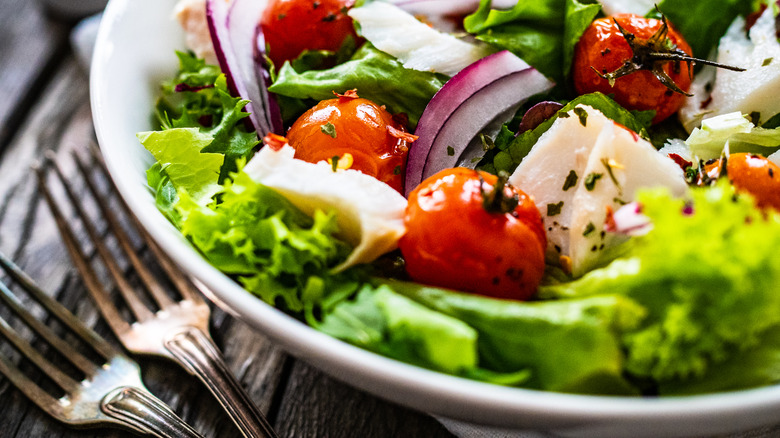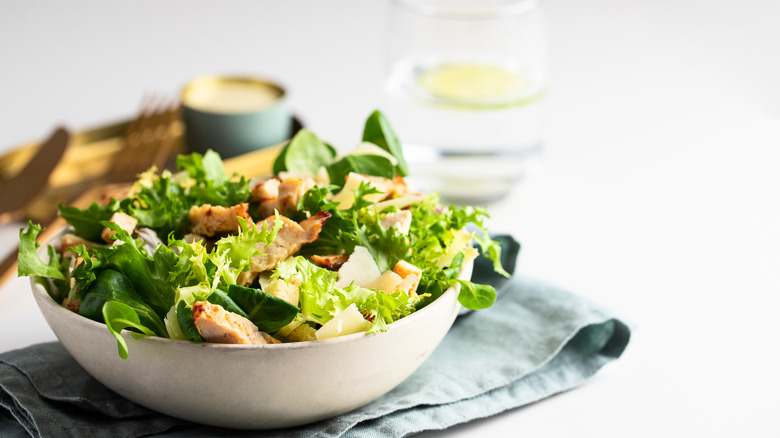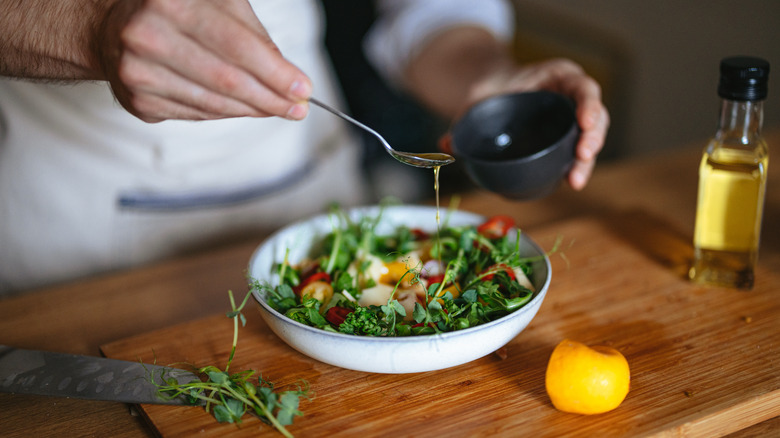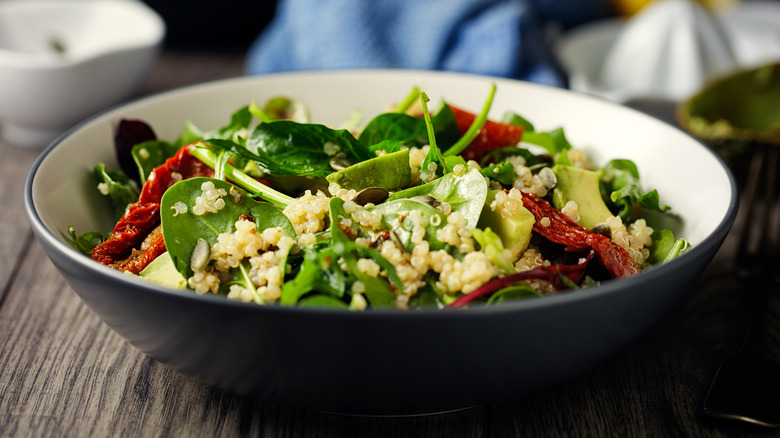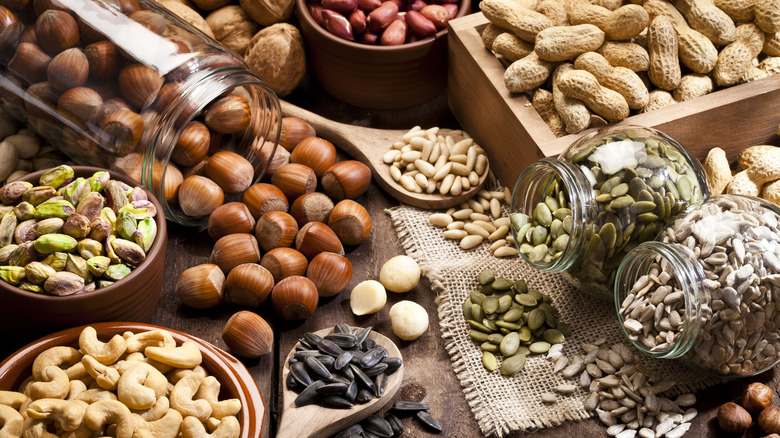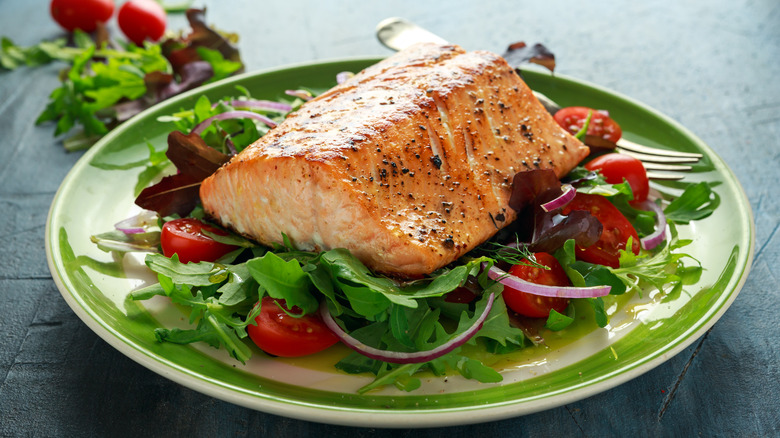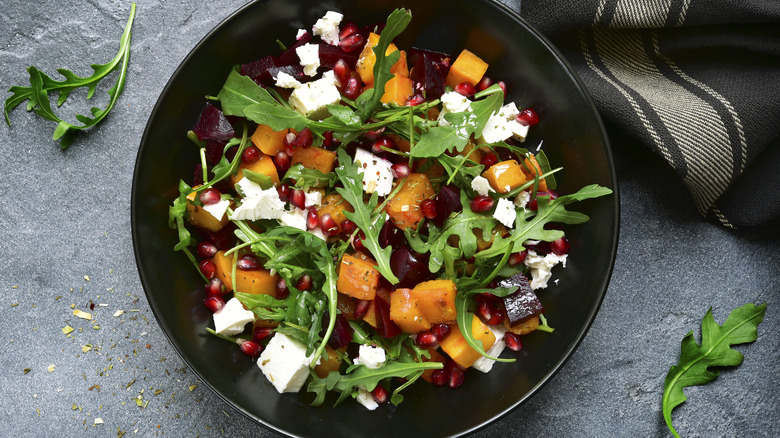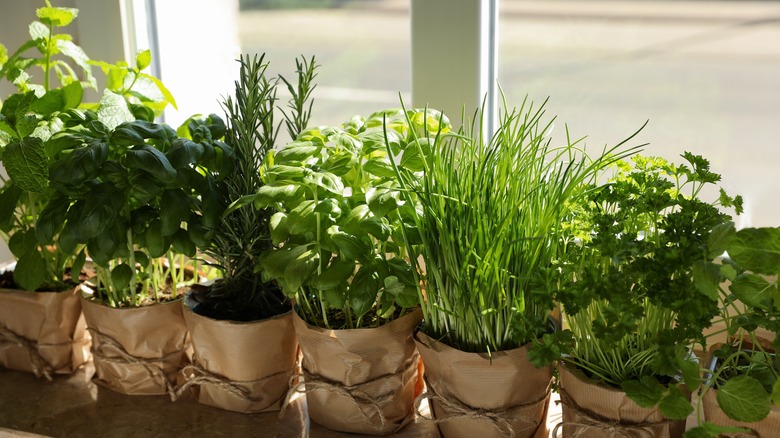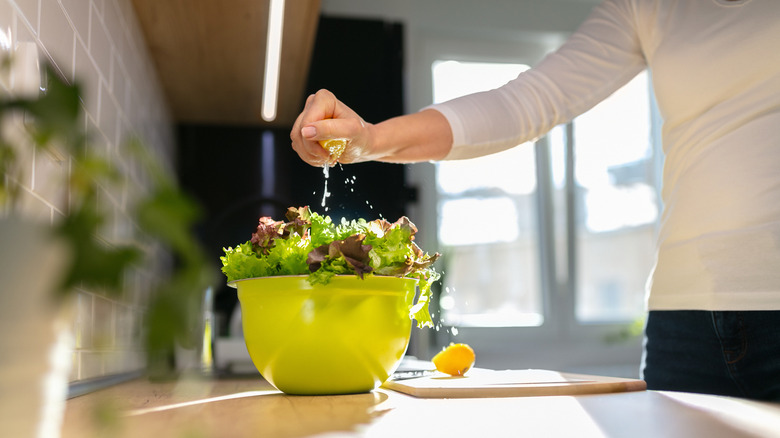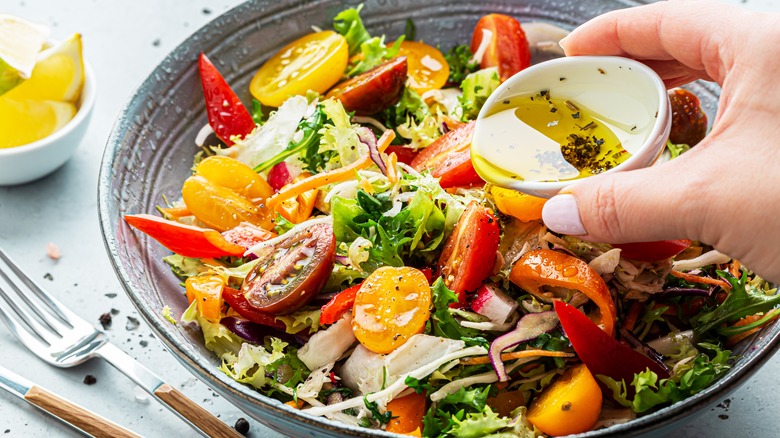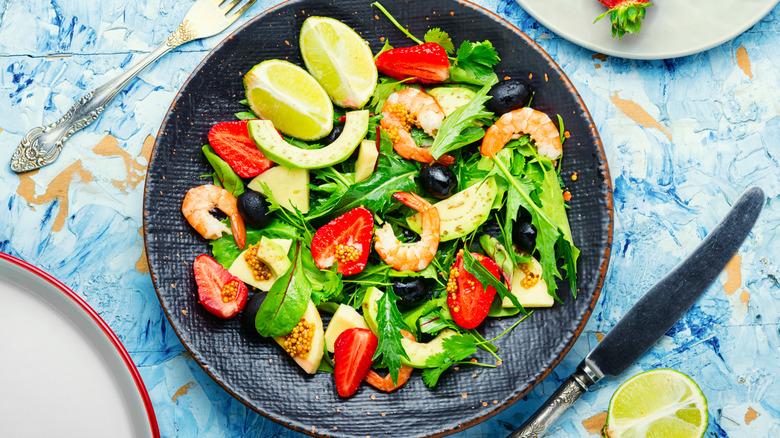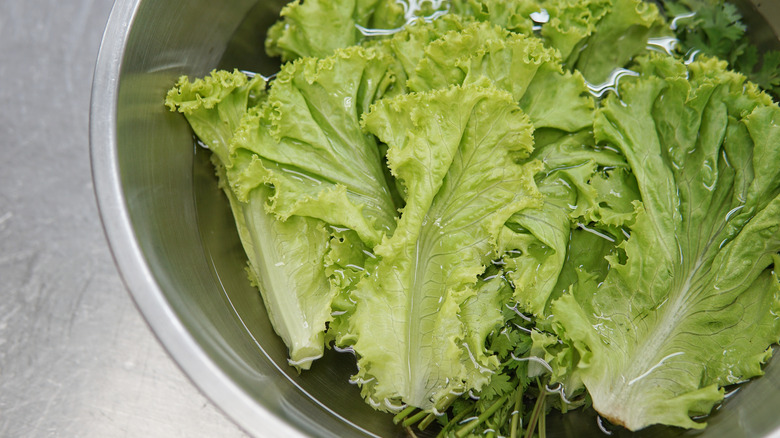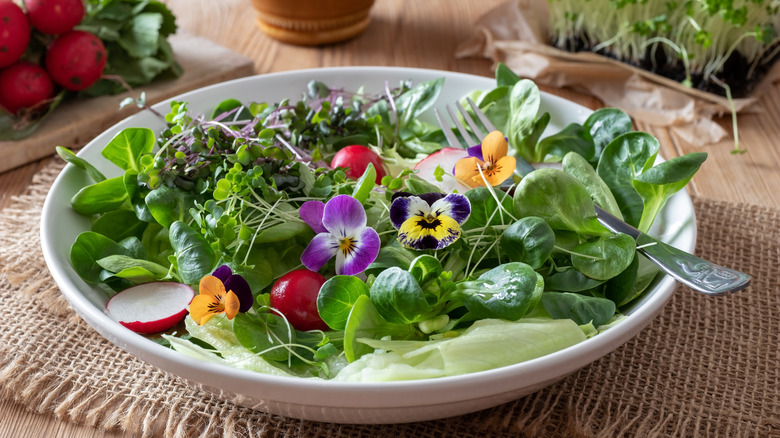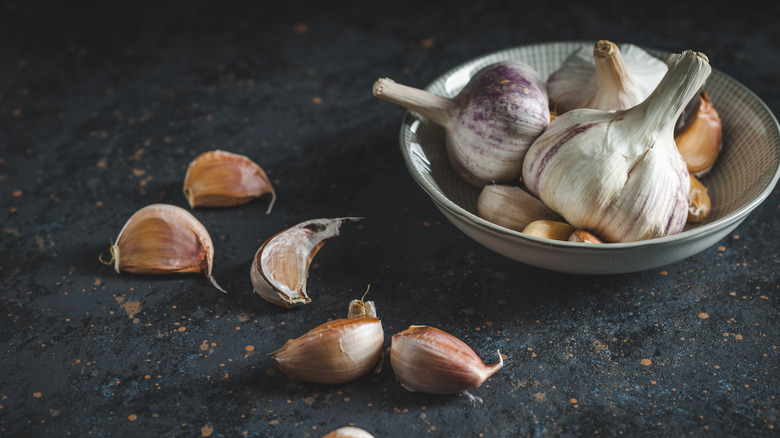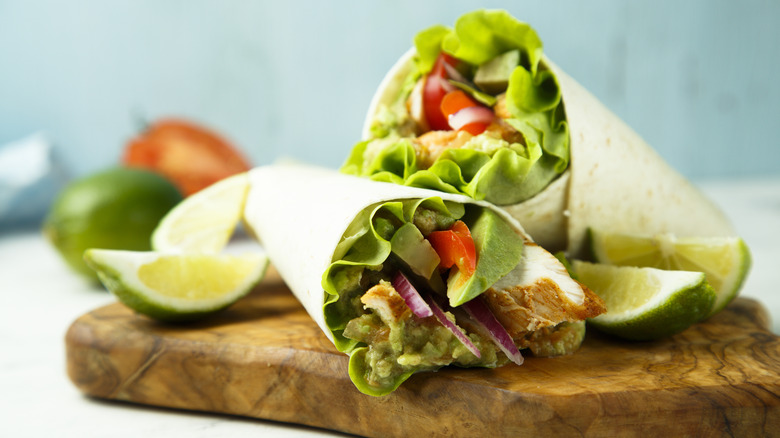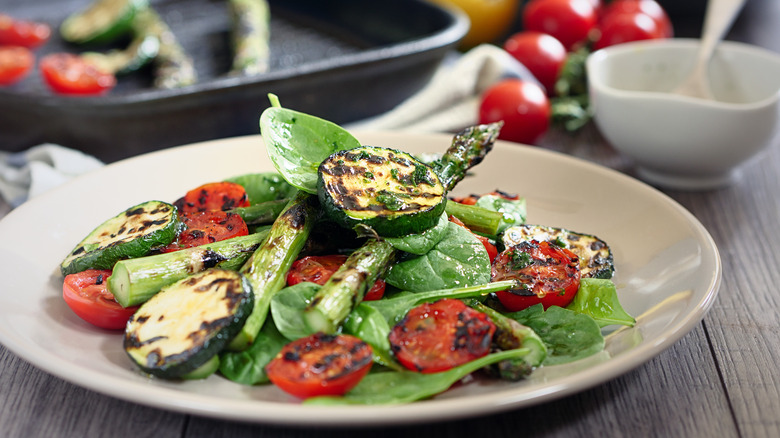15 Ways To Upgrade Bagged Salad
Bagged salads are one of humanity's greatest inventions for quick, healthy, and convenient meals. However, let's be honest — they can sometimes be a bit bland and uninspiring on their own, lacking the excitement and flavor punch we crave in a truly satisfying dish. While it's tempting to simply open a bag, toss in the dressing, and call it a day, there are easy ways to transform these humble greens into vibrant, flavor-packed meals that don't look like they came from a bag.
Elevating your bagged salad can be easier than you think. Sometimes, all you need to do is add some more ingredients, sprinkle a little something on top, or prepare your bowl in a different way. These tips not only enhance the flavor but also upgrade the texture, presentation, and even the nutrients of the salad in question. Feel free to pick and choose some of these simple tricks to make a bagged salad your own hearty creation.
1. Add a protein
While bagged salads provide a convenient mix of vegetables and toppings, they can sometimes fall short in the protein department. Adding protein-rich ingredients is crucial because they provide a feeling of fullness that you may not get from vegetables alone. Beyond that, tossing in protein also elevates the salad's taste, texture, and nutritional value.
Consider grilled chicken or turkey breast as a protein source, not just for their lean protein content but also for the savory, smoky notes they add to a salad. Similarly, canned tuna or salmon are also popular choices, offering not only protein but also a boost of omega-3 fatty acids and a rich umami flavor. Similarly, for adding creamy texture and savory taste, hard-boiled eggs can be a perfect choice.
Plant-based protein options such as chickpeas, tofu, and black beans are also excellent additions. These ingredients not only deliver a protein punch but also bring along a good dose of fiber, aiding in digestion and providing satiety.
2. Make your own dressing
Making your own dressing is a game-changer when it comes to upgrading a bagged salad. While the dressings included in salad kits are convenient, they often contain ingredients you might prefer to avoid and fall a little short of personal tastes. Creating your own dressing allows you to control the ingredients and tailor the flavors to suit your specific preferences, leading to a fresher, healthier, and more flavorful meal.
Although there are countless salad dressings you can make at home, most can be categorized as either a vinaigrette or a creamy dressing. Making a basic vinaigrette is as easy as combining three parts oil with one part acidic liquid of your choice. Creamy dressings, on the other hand, combine acid with fat, such as mayonnaise, sour cream, or yogurt.
From this starting point, you can easily adjust the flavors and ingredients to create the perfect dressing and add a personal touch to your meal. Opting for unique ingredients and experimenting with different options, such as swapping mayonnaise for Greek yogurt, can make your salad even more delicious.
3. Add whole grains
Whole grains are essential components of a healthy diet, and they can elevate a salad to new heights. These dietary building blocks are great sources of fiber, which is essential for your digestive health and can help keep you feeling full and satisfied after a meal. They are also packed with various vitamins and minerals, making them a nutritious addition to any salad.
Whole grains come in a variety of options, each with its own unique benefits and flavors. Quinoa, for example, is not only nutrient-dense but also considered a nearly complete source of protein because it contains all nine of the essential amino acids. Its light and fluffy texture and mild flavor also pair well with a wide range of salad ingredients. Brown rice is another popular whole grain known for its superior nutrient profile; it also boasts a chewy texture and slightly nutty flavor. Other notable options include farro, buckwheat and barley, each offering its own set of nutritional benefits and adding interesting textures and flavors to salads. Experiment with them all until you find your favorite.
4. Add some crunch
Adding crunchy elements to your bagged salad is a simple yet effective way to upgrade its texture, flavor, and overall appeal. They provide a satisfying contrast to the softer leafy base and make each bite much more enjoyable.
Nuts and seeds, such as almonds, walnuts, sunflower seeds, or pumpkin seeds, are all excellent options for adding that crunch factor. Besides their delectable texture, they also provide a dose of healthy fats, protein, and fiber. All you have to do is sprinkle them onto the salad to enjoy the rich, nutty flavor.
Another great way to add crunch to your salad is with crispy vegetables, such as carrots, bell peppers, and cucumbers. These vegetables not only add texture but also contribute to the salad's nutritional value. Additionally, you can also try adding crispy fruits, such as apples or pears, for a sweet twist. For a more indulgent option, consider adding some fried shallots or onions.
5. Incorporate healthy fats
Fats often get a bad rap, leading many people to avoid consuming them. However, not all fats are created equal. In fact, healthy fats, such as unsaturated fats and omega-3 fatty acids, are important sources of energy that help you feel full for longer periods of time. Additionally, fats help you absorb vitamins that are present in your other salad ingredients, such as vitamins A, D, E, and K.
Avocado is a popular and delicious choice to add healthy fats to your bagged salad. It contributes a rich, creamy texture and a mild nutty flavor. It's also packed with heart-healthy fats, fiber, and vitamins. For a simpler option, you can use olive oil to make a vinaigrette dressing or drizzle it directly over the salad. Besides being a source of healthy fats, olive oil is rich in vitamin E and other antioxidant compounds that can help prevent heart disease and promote brain function. Nuts and seeds are also excellent sources of healthy fats that also add crunch and flavor to your salad.
6. Toss in some cheese
Cheese makes everything better, and your bagged salad is no exception. It brings a rich, creamy texture, savory flavor, and a boost of calcium and protein. It's also a versatile option, with a wide array of variants to choose from according to your palate. Whether you prefer a soft, creamy cheese or a hard, crumbly one, adding cheese is a surefire way to upgrade your salad and make it more delicious and satisfying. You can even make simple cheese crisps for a unique twist.
Feta is a popular choice for good reason; it adds a creamy texture and a distinctive briny flavor that pairs exceptionally well with salads, especially those with Mediterranean-inspired ingredients. Goat cheese is another excellent option that can add richness and velvety texture that takes your salad to the next level, particularly when combined with fruit and nuts. Parmesan contributes a salty flavor that complements a variety of ingredients, particularly bitter greens like kale and broccoli. For those seeking a more familiar and comforting option, cheddar is always a crowd-pleaser in salads, whether shredded or cubed.
7. Don't forget about fresh herbs
A few fresh herbs go a long way when it comes to elevating your salads. Adding a handful of these aromatic plants can transform a simple bagged salad into a flavorful and visually appealing dish. Although fresh herbs are often viewed as mere seasonings or garnishes, they're actually packed with nutrients such as vitamins, minerals, and antioxidants, and should be treated as serious ingredients in their own right.
Consider adding a handful of chopped parsley for herbaceous flavor. Or, for a zesty, citrusy kick, try cilantro, which pairs well with Mexican and Asian-inspired salads. Basil is another versatile herb that can add a sweet and summery twist to your salad. Whichever you choose, fresh herbs can take your salad from bland to bold in an instant, with vibrant flavors that complement a wide range of ingredients.
Incorporating fresh herbs into your bagged salad is also easy and requires minimal effort. Simply wash and chop the herbs of your choice, then toss them with your salad ingredients. You can also use fresh herbs to make a simple dressing or vinaigrette, adding even more flavor and freshness to your salad.
8. Add something acidic
Even the dullest bagged salad can pack a punch if you add a zesty twist. Acidic ingredients, such as vinegar, citrus juice, or even pieces of fruit, can help bring out the natural flavors already present in your salad, making the whole dish more vibrant and delicious. By adding a touch of acidity, you also offset the richness and fat in ingredients like chicken, cheese, or creamy dressings, making your salad more balanced.
To add acidity to your bagged salad, simply choose between citrus juices, such as lemon, lime, or orange, for bright, refreshing flavor. If you're feeling a bit more adventurous, consider experimenting with acidic fruits like tomatoes, strawberries, or pineapple for a unique twist and a subtle sweetness that enhances the complexity of your salad. In addition to fruits, vinegars like balsamic or apple cider vinegar can also provide tangy flavor that pairs well with most salad ingredients.
9. Use the entire rainbow
Eating a bagged salad doesn't mean you can't eat the rainbow. Color cues play an important role in our perception of food — in fact, the appearance of food is often just as important as its taste. For instance, bright, vivid colors signal freshness and increase your appetite. Furthermore, the combination of different colors, flavors, and textures creates a feast for the senses that makes your salad not only visually appealing but also more satisfying and enjoyable.
Most bagged salads come in greens, so it's up to you to introduce other colors. You can add red from tomatoes, orange from carrots and sweet potatoes, yellow from corn and bell peppers, purple from cabbages, and even white from cauliflower and tofu. These colors not only make your salad more mouthwatering, they indicate the diverse range of nutrients present in your meal. Each color represents different elements, contributing to a well-rounded and nutritious dish. Plus, a colorful salad just looks nicer, making it an ideal choice for a gathering.
10. Add fruits
Your bagged salad doesn't have to be bland. Incorporating fruits can transform a simple dish into a flavor-packed sensation, and play off the salad's bitterness, earthiness, or pungency in interesting ways. Fruits add a natural sweetness, a burst of freshness, and a variety of vitamins and antioxidants to your bagged salad, making it more delicious and nutritious.
Adding fruits to your bagged salad is easy and can be done with a variety of fruits. Berries like strawberries, blueberries, and raspberries are excellent choices that add lovely color and bright flavor. Sliced apples or pears can contribute a crunchy texture and tangy sweetness, providing a delightful contrast to the leafy greens. You can also mix it up with tropical fruits like mango, pineapple, and kiwi for an exotic twist and fresh flair.
If you're unsure about which fruits to mix into your savory salad, try eating them as a side dish first and gradually combine them as you go. Who knows — maybe you'll discover a unique taste combination that becomes a new favorite.
11. Crisp your leaves
As convenient as bagged salads are, they can easily become limp or soggy after spending time on the store shelf or forgotten in your fridge. Fortunately, there's a simple way to revive their crispness and bring back that satisfying leafy crunch in every bite.
To start, prepare a large bowl of ice water. Submerge your greens in the ice water and let them soak for 15 minutes. For more severely wilted leaves, you can extend the soaking time to 30 minutes. Alternatively, you can use warm water instead of ice water. Both methods work effectively, so feel free to choose the one that is most convenient for you.
The key to this method is hydration. Bagged vegetables lose water over time, which is why soaking them in water — whether cold or warm — helps rehydrate them and restore their crisp texture. After soaking, remove the greens from the water and pat or spin them dry before eating. This simple trick can really make a difference in making your bagged salad fresher and more appetizing.
12. Add something unexpected
Transforming a mundane bagged salad into a culinary adventure is easier than you might think. Adding a single unique ingredient can really make a difference, bringing more excitement, flavor, and potentially additional nutrients into the mix.
Incorporating edible flowers can instantly make your bagged salad look gourmet. Not only do they add a beautiful visual element, they also bring delicate floral flavor. Hibiscus, dandelion, nasturtium, and borage are excellent options for salad, offering nutritional benefits along with their aesthetic appeal.
For a satisfying crunch and rich, savory flavor, consider adding crispy onions to your salad. They complement a variety of salad ingredients while providing vitamins, minerals, and antioxidants. Coconut flakes can also be a delightful addition, offering sweet, tropical flavor and chewy texture that bring a unique twist to your salad. Experimenting with different ingredients, including those you may not typically find in salads, can lead to exciting flavor combinations that take your bagged salad to another level.
13. Rub your bowl with garlic
The beauty of bagged salads lies in their convenience. This means that sometimes, keeping things simple is the best approach. Rubbing your salad bowl with garlic is easy as pie, and it infuses the dish with a pungent flavor and a pleasant savory base. To do this, cut a clove of garlic in half and rub the inside of your bowl with it before adding your salad ingredients. Make sure to do this thoroughly to release the garlic's natural oils. This trick is particularly effective when creating a salad with vinaigrette dressing, as rubbing the garlic on the bowl instead of mixing it into the dressing prevents it from overpowering the other flavors.
Aside from its delectable flavor and aroma, garlic also offers a range of health benefits. It contains vitamins and minerals, including vitamin C, vitamin B6, and manganese. Garlic is also known for its immune-boosting and anti-inflammatory properties, making it a valuable addition to your diet.
14. Make a wrap
Enjoy your bagged salad in a whole new way by turning it into a wrap, creating a meal that is not only more convenient but also more satisfying. The wrap itself adds texture and flavor, providing a soft and chewy base that complements the crunchy texture of the leaves. It can also help your salad become more hearty and filling, seamlessly adding protein and fiber into the mix.
Creating a salad wrap is simple and fun. Begin by selecting your wrap base. Corn or whole-grain tortillas provide more fiber and protein, but simple flour tortillas are an excellent choice too. Then spread your salad ingredients and dressing evenly onto the wrap. Fold the sides of the wrap over the filling, then roll it up tightly from the bottom. And there you have it, a complete and nutritious meal that is convenient to enjoy on the go. Whether you're looking for a quick lunch or a light dinner option, this salad wrap is sure to satisfy.
15. Add grilled veggies
While the vegetables in bagged salads are typically raw, there's no rule saying your entire meal has to be. Adding grilled veggies can elevate the dish in a snap. Grilling caramelizes the natural sugars in vegetables, intensifying their sweetness and adding a rich, smoky flavor that will take your salad to the next level.
Beyond enhancing flavor, grilled veggies also add satisfying texture to your salad. Their charred edges and tender interiors offer a pleasant contrast to the crispness of the salad greens, making each bite more interesting and enjoyable. Furthermore, grilling is a healthy and versatile cooking method that can bring out even more vitamins and minerals in the food due to the high heat level.
Your options are pretty much endless, from moist vegetables like zucchini and eggplant to leafy ones like romaine and kale. Simply brush your favorite vegetables with olive oil, season them with salt and pepper, and grill them until they are tender and lightly charred.
